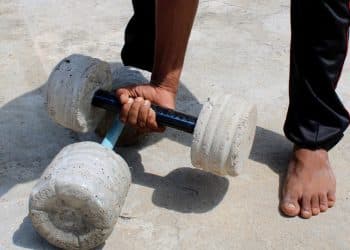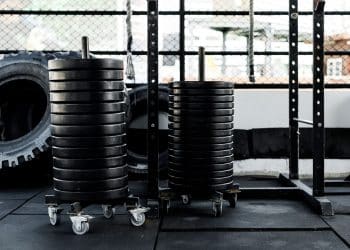A weight bench is one of the central pieces in a gym. A basic commercial weight bench for a home gym costs at least $90. Opting for a better quality bench with additional features can cost you north of $150.
I have helped more than 20 home gym owners build a custom weight bench for their home gym. In this article, I’ll help you design and build a DIY weight bench for your gym for your unique needs.
6 Homemade Weight Bench Ideas
Here are six homemade weight bench ideas for your garage or basement gym:
1. Plywood Weight Bench
The plywood weight bench blueprint below is an excellent choice for beginners and advanced lifters alike. It is a sturdy bench that can handle a lot of weight, and the design is simple enough that a DIY beginner can build it on their own. The plywood weight bench is the bench that I recommend to most new DIY gym owners.
Tools and Materials:
- 4×4 lumber — 2 pieces cut at 10.5 inches for vertical posts
- 4×4 lumber — 2 pieces cut at 14.5 inches for base
- 4×4 lumber — 1 piece cut at 40 inches for top
- 2×12 50-inch plyboard for back support
- 7-inch tie plate braces
- 2-inch exterior screws
- Measuring tape
- Pencil
- Drill machine
Steps:
This is how to assemble the plywood weight bench for the best results:
Step One — Get All the Materials
All DIY projects begin with gathering all the materials you’ll need for your design. People who don’t own power tools should get the wood cut at the hardware store. Alternatively, you can get the wood of the exact dimensions online.
Level Up Your Fitness: Join our 💪 strong community in Fitness Volt Newsletter. Get daily inspiration, expert-backed workouts, nutrition tips, the latest in strength sports, and the support you need to reach your goals. Subscribe for free!
Step Two — Set up the Base
Place the two 14.5-inch 4×4 lumber pieces horizontally on your work table. Then, position the two 10.5 4×4 pieces over them horizontally.
Now, bend the 7-inch tie plates at 90 degrees in the middle to attach the base with the legs. The braces are thin, and you can bend them using your hands by placing them on your desk’s edge. Put one brace on each side of the leg where the vertical poles touch the base. Drill wood screws through the tie plates into the wood to secure them in place. Use 10-15 screws on each brace.
Expert Tip: Ensure the vertical posts are in the center of the base pieces. Mark the exact position using a measuring tape and a pencil.
Step Three — Attach the Top
Stack the 4×4 40-inch lumber on top of the legs. Use the braces and wood screws to attach the legs to the top. Use three tie plates on each leg to build a robust bench base. Drill diagonally through the legs into the top for a secure attachment.
Step Four — Add the Back Support
Center the plywood over the bench’s base. Use a tape measure to ensure the plywood is in the center. A misaligned back support can lead to stability issues during the workouts, increasing your risk of injury.
Bend the braces at 90 degrees and use them to attach the bench’s base to the plywood. Turn the bench upside down to install these tie-ins.
Pros of Plywood Weight Bench:
- People with minimum experience with DIY projects can build this in under 30 minutes.
- Costs less than $30 to build.
- Since this is a straightforward design, you could easily change the dimensions to fit your needs. However, you must ensure you don’t hamper its structural integrity.
Cons of Plywood Weight Bench:
- Not ideal for people who want an adjustable bench.
- People who plan on lifting heavy on this bench must add a cushion on the top to prevent the wood from digging into your back.
2. Homemade Weight Bench With Wheels
The biggest mistake I see people make while building DIY weight benches with wheels is that they attach the wheels directly to the bottom of the legs. This is a rookie mistake that skyrockets your chances of injury while training. Irrespective of whether the wheels have built-in stoppers, bench pressing heavy weights on such a bench will cause instability.
Many home gym owners opt for this design because it is easy to build. However, the weight bench idea you’ll read about now is just as easy; it just changes the position of the wheels, so you don’t have to worry about rolling down your gym mid-set.
Tools and Materials:
- 4×4 lumber — 2 pieces cut at 10.5 inches for vertical posts
- 4×4 lumber — 2 pieces cut at 14.5 inches for base
- 4×4 lumber — 1 piece cut at 40 inches for top
- 2×12 50-inch plyboard for back support
- 7-inch tie plate braces
- 2-inch exterior screws
- Measuring tape
- Pencil
- Drill machine
- 1-inch Dowel
- 2 x Caster wheels
- Paint
Steps:
Here is how to build the homemade weight bench with wheels:
Step One — Build the Plywood Weight Bench
Use the steps mentioned in the blueprint above to build a DIY homemade weight bench. The three extra things you need for this project include caster wheels, a 1-inch dowel, and paint.
Step Two — Attach the Caster Wheels
After you have the weight bench ready, place the caster wheels on the front side of the bench’s legs 3-4 inches off the floor. Use a pencil to mark the holes of the caster wheels on the lumber. Pre-drill the holes to prevent the wood from cracking. Secure the caster wheels to the lumber using wood screws.
Expert Tip: The position of the wheels on the bench’s legs will depend on their size. Smaller wheels must be attached near the base, whereas bigger ones can be slightly higher.
Step Three — Install the Dowel
Attach a dowel on the other side of the bench using wood screws. A dowel makes it easier to navigate the bench through your gym. However, ensure that the dowel isn’t too long, as it can otherwise interfere with your workouts.
Step Four — Paint (Optional)
Painting the bench makes it look much more aesthetically appealing. You could use a paint color that matches your gym’s color scheme. Furthermore, paint acts as a protective layer for your equipment, significantly improving its longevity.
Pros of Homemade Weight Bench With Wheels:
- Incredibly easy to move around. A must-have for people with congested home gyms.
- Castor wheels are usually low maintenance and last you a long time.
Cons of Homemade Weight Bench With Wheels:
- Not suitable for people who want an adjustable bench.
3. Adjustable Weight Bench
Adjustable benches are non-negotiable for people who train for hypertrophy. You must hit your muscles from different angles to ensure overall development, and an adjustable weight bench helps with this objective. (1)
Tools and Materials:
- 5/8″ Dowel
- Table saw
- Mitre or circular saw
- Deck screws
- Miller dowels
- Wood glue
- 2×4 lumber in the following lengths:
- 4 × 382 mm
- 2 × 286 mm
- 4 × 105 mm
- 2 × 940 mm (both ends cut at 45 degrees for miter)
- 2 × 155 mm (ends cut at 45 degrees for miter; will trim to fit precisely at a later step)
- 1 × 560 mm (ends cut at 45 degrees, parallel)
- 1 x 4-foot 12” Plywood (3/4″ thick), cut into the following lengths:
- 1 × 320 mm
- 1 × 700 mm
Steps:
Follow these step-by-step instructions to build this bench:
Step One — Get the Material Ready
People who cannot use power tools should get the wood cut at their local hardware store. The sturdiness of this homemade weight bench will depend on the precision of the wood cuts.
Step Two — Apply Glue on the Feet and Legs
Attach the legs with two slightly angled 3-inch deck screws at the top and bottom. Predrill the holes to prevent the wood from cracking. Apply wood glue to both faces of the wood and rejoin them.
Leave enough space while assembling the feet to fit the bench’s legs between two small blocks. Repeat the screwing and gluing process from above.
Expert Tip: Drill the holes so they won’t come in the way of the miter cut. As a rule of thumb, always read through the entire DIY steps before starting a project.
Step Three — Frame
Attach the lumber on both sides of the legs using wood glue and screws. Use an orbital sander to tidy up the bench.
Step Four — Add Seat and Back
Secure a cross-piece 300 millimeters from the frame’s front to hold the hinges for the back piece. Recess the hinges using a router and a chisel to ensure the back is the same height as the seat.
Step Five — Add Prop
The incline feature of this bench is enabled by an angled wood piece, having a 560-millimeter-long edge with parallel 45-degree angles at each end. This piece of wood should be made using a 2×4 35mm wide lumber. Drill 5-millimeter holes every 50 mm using a drill press and a Forstner bit.
Attach this piece of wood using glue and fasteners as far to the rear as possible so it doesn’t interfere with the frame. Make another 75-millimeter wide and 300-millimeter long 2×4 piece with a 45-degree miter cut at one end. Use this to reinforce the spine.
Insert a dowel through the holes to set the incline angles.
Level Up Your Fitness: Join our 💪 strong community in Fitness Volt Newsletter. Get daily inspiration, expert-backed workouts, nutrition tips, the latest in strength sports, and the support you need to reach your goals. Subscribe for free!
Pros of Adjustable Weight Bench:
- Perfect for lifters who want an adjustable bench.
- The small footprint of this bench makes it suitable for most home gyms.
Cons of Adjustable Weight Bench:
- Requires prior woodworking experience.
- The wooden surface is not the most comfortable to train on.
4. Metal Weight Bench
The metal weight bench is made using steel pipes, tees, and elbows. It is arguably the most straightforward DIY homemade weight bench you can build.
Tools and Materials:
- Pre-cut steel pipes (1-inch diameter):
- 4 x 48 inches long (for the legs)
- 2 x 36 inches long (for the bench’s base)
- 2 x 48 inches long (for the bench’s top frame)
- 2 x 12 inches long (for the backpad’s vertical supports)
- Steel tees (1-inch diameter) and elbows
- Steel flanges (1-inch diameter)
- 48×12” Plywood for the bench top
- Screws
- Measuring tape
- Wrench
Steps:
Use the following tips to build your DIY metal weight bench:
Step One — Assemble the Frame
Attach two 48-inch steel pipes to two steel tees to build the legs. Attach steel flanges to the bottom of each leg. The steel flanges will serve as the bench’s feet and provide stability.
Step Two — Create the Bench Base
Connect two 36-inch steel pipes to the open ends of the tees to build the bench’s base. Then, attach a steel tee to each end of the 36-inch pipe, with the opening facing up and down.
Step Three — Build the Top Frame
Connect two 48-inch steel pipes to the tees’ open ends on the base to form the bench’s top frame.
Step Four — Attach the Bench’s Top
Secure the plywood top to the top frame using screws. Ensure the plywood is level and stable; add additional screws if necessary.
Expert Tip: Feel free to change the plywood’s dimensions depending on your preferences. Some powerlifters find that a wider bench provides better shoulder and upper back stability.
Pros of Metal Weight Bench:
- An easy DIY homemade weight bench project to build.
- Metal benches are generally more stable than wooden ones.
Cons of Metal Weight Bench:
- Not the ideal weight bench design for DIY beginners who cannot find steel pipes of the right length. Cutting steel pipes requires power tool prowess.
5. Foldable Weight Bench
A foldable weight bench is an excellent choice for people with limited real estate in their home gym.
Tools and Materials:
- 4 x 2×4 lumber, each 48 inches long (for the legs)
- 2 x 2×6 lumber, each 48 inches long (for the bench’s base)
- 2 x 2×4 lumber, each 48 inches long (for the bench’s top frame)
- 1 x 3/4-inch plywood, 48×14 inches (for the bench’s top)
- 1 x 3/4-inch plywood, 48×12 inches (for the backpad)
- 2 x 2×4 lumber, each 12 inches long (for the backpad’s support)
- 4 x heavy-duty hinges
- Cushion foam and fabric for the backpad
- Screws
- Measuring tape
- Woog glue
- Drill
- Saw
Steps:
Build a foldable weight bench using the following steps:
Step One — Assemble the Legs
Position two 2×4 legs together in pairs on the workbench, parallel to each other. Attach a heavy-duty hinge to the top of each leg pair, ensuring they fold inward. Ensure the hinges work perfectly as they create the folding feature.
Step Two — Build the Bench’s Base & Top
Position the 2×6 lumber parallel to each other and attach the 2×4 top frame pieces to the ends. Attach them using wood screws and glue. Place the legs at each corner of the base. Secure the legs with the base using glue and screw. Attach the 48×14-inch plywood piece to the top frame using the trusted glue and screw.
Step Three — Construct the Backpad
Secure the 2×4 support pieces vertically to the back of the 48×12-inch backpad with screws.
Expert Tip: You could add a cushion foam of the same size on the backpad. Cover the foam with fabric and secure it to the plywood using a staple gun.
Pros of Foldable Weight Bench:
- You can place this weight bench flat against the wall after each use, freeing up a lot of space in your home gym.
- Foldable weight benches are easier to carry around than fixed-weight benches.
Cons of Foldable Weight Bench:
- Requires decent craftsmanship. A weak or structurally flawed foldable bench can collapse in the middle of a set, increasing your risk of injury during training.
6. Bench Press Weight Bench
Serious lifters should have a bench press in their home gyms. A bench press is more stable and sturdy and can support more weight than a standalone weight bench.
Tools and Materials:
- 2x4x8′ (x7)
- 49″x10″ – 3/4″ Plywood
- 2 x 1/2″ Wood Screws
- 1-inch Thick Closed Cell Foam
- Fabric
- 1/2″ Stapes
- Tape Measure
- Drill
- Miter Saw
- Staple Gun
- Nail Gun
- Skill Saw
Steps:
This is how to build a DIY bench press:
Step One — Assemble the Legs
Cut a 2×4-inch wood block to 48 inches and another to 24 inches using a skill saw. Chamfer the edges of the shorter piece on both ends at 45 degrees. Chamfer one end of the 48-inch piece. Attach the chamfered end to the 24-inch piece 2¾ inches from the front edge. Attach the pieces using wood screws and glue. Repeat this process for the other set.
Cut two wood pieces to 10¾ inches lengths with 45-degree chamfers on both ends. Place the pieces on the post’s shorter side and attach it using wood screws.
Cut two wood blocks to be 3 inches in length. Attach them to the front side of both posts using a nail gun. Then, cut another 2×4-inch wood block into a 48-inch plank. Set the stands 48 inches apart and place this plank over the 3-inch blocks and attach them using screws.
Expert Tip: Double-check the dimensions at each point to ensure the bench’s structural integrity.
Step Two — Build and Attach the Barbell Support
Attach two more 3-inch wood blocks over the 48-inch plank on both ends. Then, add another 48-inch piece over the 3-inch blocks. Fasten two 20-inch pieces vertically on both posts over the 48-inch pieces.
Step Three — Attach the Front Diagonal Support Piece
Cut two 2×4-inch wood blocks to a length of 36 inches. Place two 10¾-inch pieces diagonally on one end of the 36-inch pieces and attach them using 21/2-inch wood screws. Attach the 36-inch piece to the front of the stand using wood screws.
Step Four — Build and Connect the Legs
Place two 16½-inch pieces on both sides of the 13 ½-inch pieces and attach them using wood screws and glue.
Cut a 2×4-inch board to a 39-inch piece and attach it to the 16½-inch pieces on the 13½-inch boards using glue and screws.
Step Five — Add the Top
Attach a 46-inch lumber piece on top of the 39-inch board for additional stability using screws. Then, secure a 49×10-inch plywood in the center of the bench using screws.
Pros of Bench Press Weight Bench:
- An incredibly sturdy weight bench.
- A must-have for powerlifters.
Cons of Bench Press Weight Bench:
- Requires a lot of time to build.
- Requires decent craftsmanship.
FAQs
Is a wooden homemade weight bench as sturdy as a metal one?
Metal weight benches are usually more sturdy than wooden ones. However, the quality of the materials used and the craftsmanship can impact the final product.
What is the maximum weight capacity of a homemade weight bench?
The maximum weight capacity of your DIY weight bench will depend on the design, quality of the materials used, and your building expertise. Test the weight capacity of a DIY homemade weight bench by placing a barbell loaded with your 1RM (one-rep max) plus 50 pounds more than your body weight.
How much does a DIY homemade weight bench cost?
A DIY weight bench can cost anywhere between $20 to $100, depending on the material used and if you choose to get external help to build the weight bench.
Wrapping Up
A weight bench is an incredibly versatile training tool that deserves a place in every gym. You could use a weight bench for plyometrics, isometric, and strength training. You could build a high-quality custom DIY weight bench for under $100.
The six homemade weight bench ideas explained in this article are suitable for people of all experience levels. Pick the one that fits your needs and start working toward your training objectives.
If you have any questions about building a DIY homemade weight bench, drop them in the comments below, and I’ll be happy to help.
References
- Krzysztofik M, Wilk M, Wojdała G, Gołaś A. Maximizing Muscle Hypertrophy: A Systematic Review of Advanced Resistance Training Techniques and Methods. Int J Environ Res Public Health. 2019 Dec 4;16(24):4897. doi: 10.3390/ijerph16244897. PMID: 31817252; PMCID: PMC6950543.











